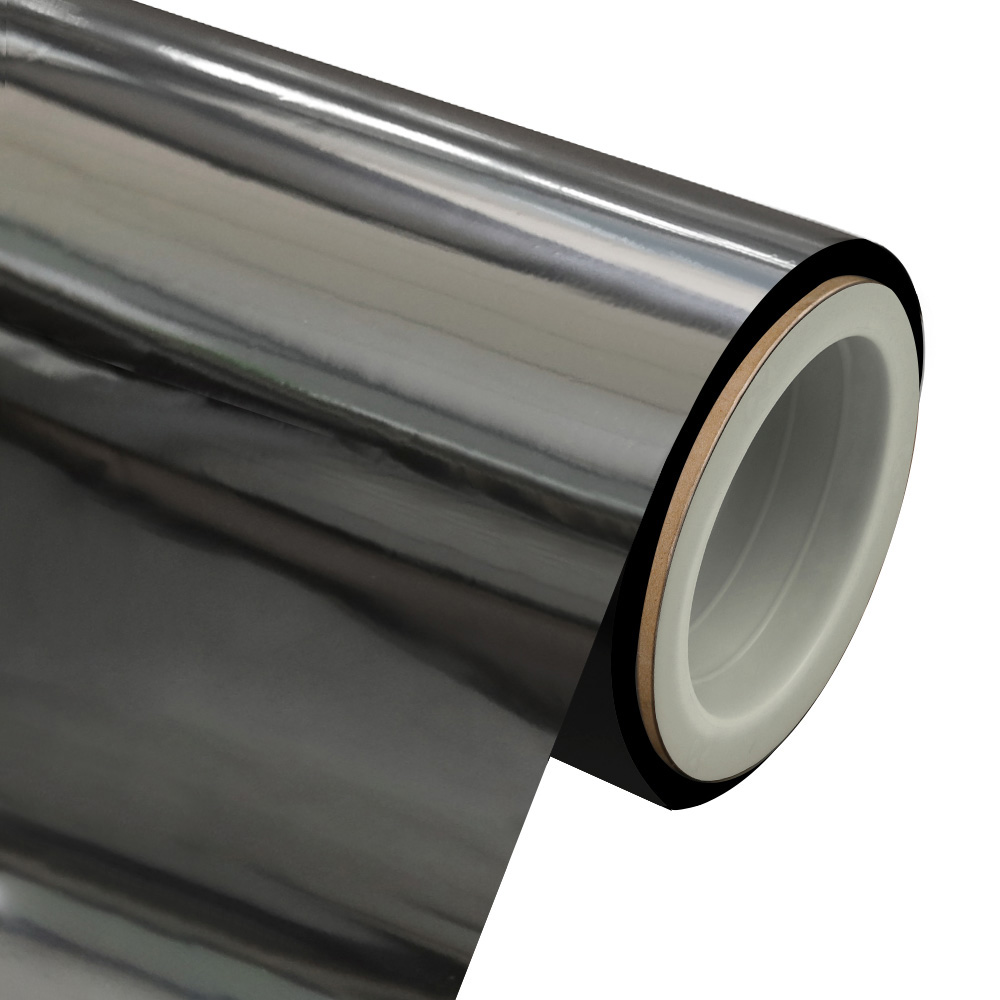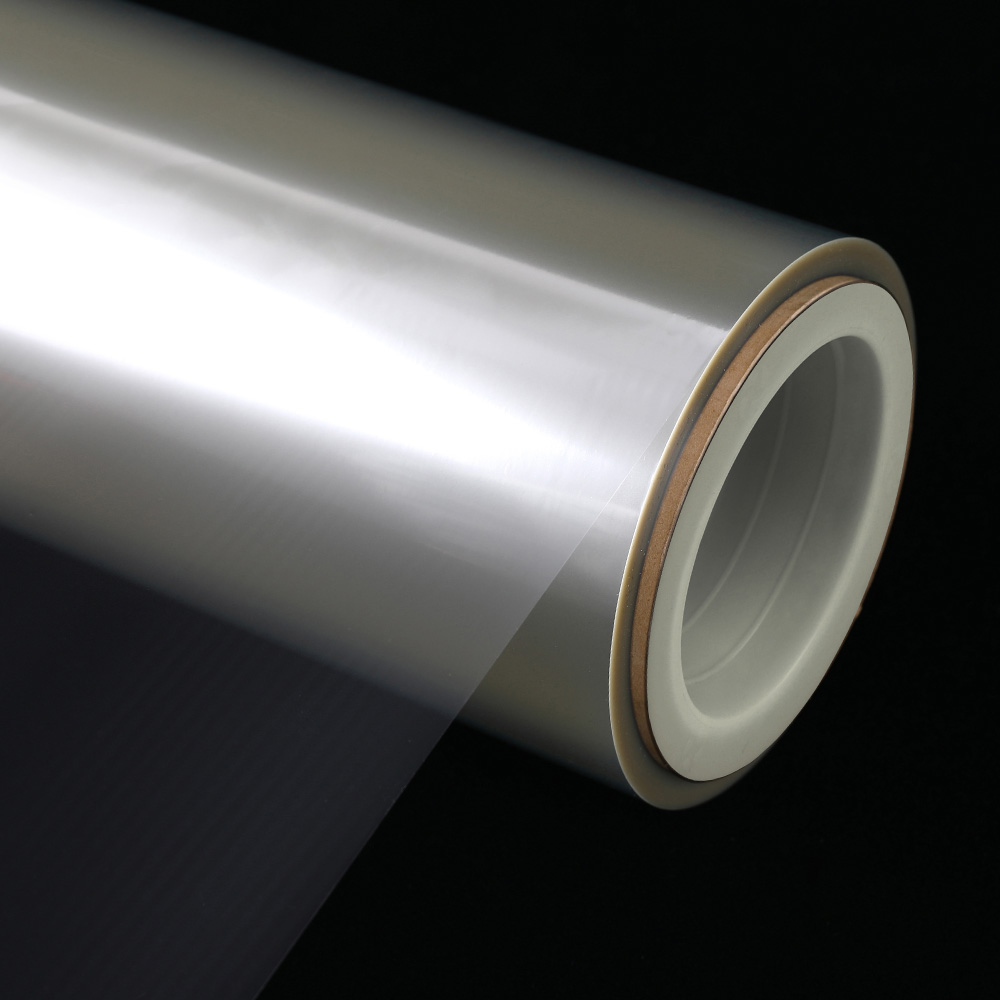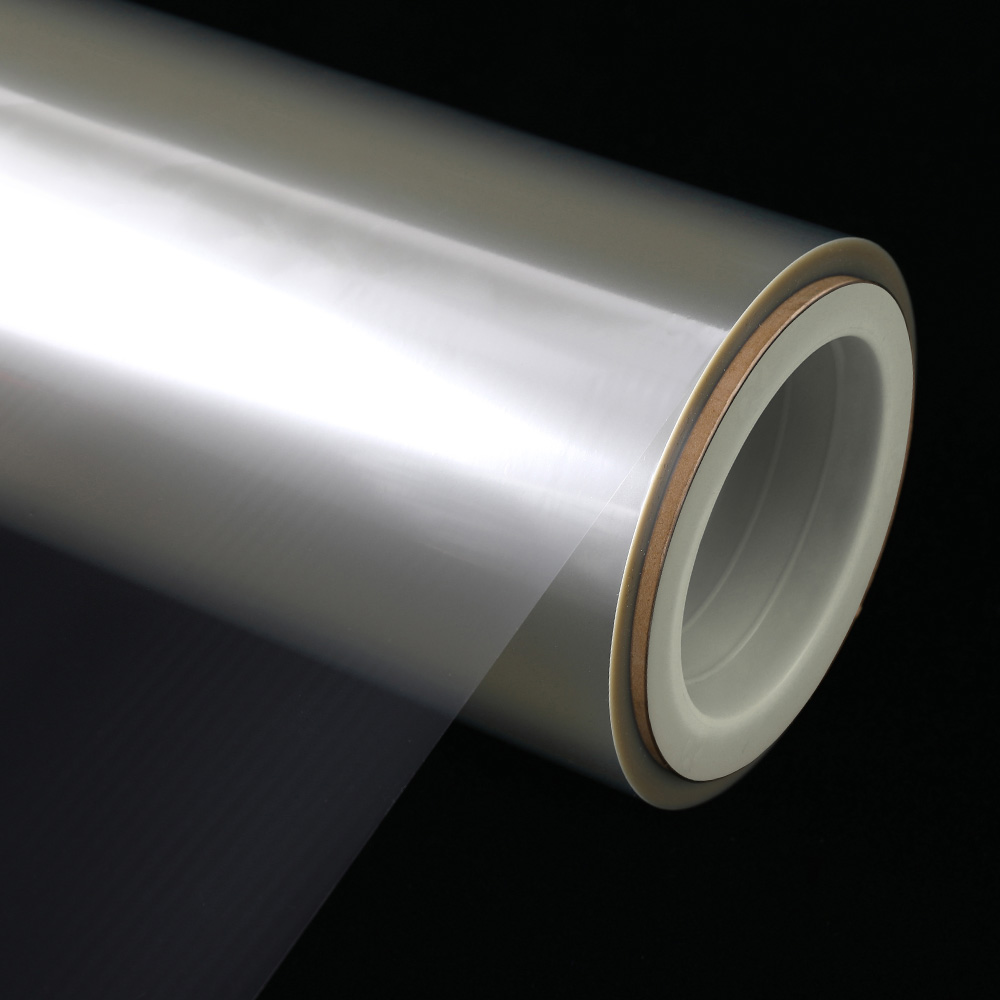What are the types of PET film?
(1) PET high-gloss film
In addition to the physical and mechanical properties of ordinary polyester films, the film also has optical properties, such as good transparency, low haze and high gloss. It is mainly used for high-grade vacuum aluminized products, the film has a mirror surface after aluminized, and has a good packaging decoration effect; it can also be used for laser anti-counterfeiting base film and so on. The high-brightness BOPET film has a large market capacity, high added value and obvious economic benefits.
(2) PET transfer film
Transfer film, also known as thermal transfer film, is characterized by high tensile strength, good thermal stability, low thermal shrinkage, smooth surface, good peelability, and can be used repeatedly. It is mainly used as the carrier of vacuum aluminum plating, that is, after the PET film is placed in the vacuum aluminum plating machine for aluminum plating, the glue is compounded with the paper, and then the PET film is peeled off, and the aluminum molecular layer is transferred to the surface of the cardboard through the adhesive effect. A so-called aluminized cardboard is formed.
(3) PET reflective film
The characteristics of PET reflective film are that the film has optical properties, the surface is smooth and clean, the thermal stability is good, the shrinkage rate is small, and it is resistant to light aging.
The reflective materials used in transportation facilities include lens-type directional reflective film and flat-top reflective film, both of which use aluminum-coated PET film as the reflective layer, and after the pressure-sensitive adhesive is coated on it, some glass with a refractive index of 1.9 is used. The microbeads are adhered to the PET aluminized film, and then a layer of butyral surface protection layer is sprayed.
PET reflective film is used in billboards with reflective requirements, traffic reflective signs (reflective road signs, reflective isolation belts, reflective license plates), reflective police uniforms, industrial safety signs, etc.
(4) Chemical coating film
In order to improve the surface properties of the PET film, to improve the adaptability of printing and the bonding force of the vacuum aluminized layer, the method of corona treatment is usually used to increase the surface tension of the film. However, the corona method has problems such as aging, especially in a high temperature and high humidity environment, the film tension after corona treatment is easily attenuated. However, there is no such problem in the chemical coating method, so it is favored by the printing industry and the aluminum plating industry. Jiangsu Zhongda has developed a series of PET chemical coating products: such as coating with water-soluble polymer, it can improve the surface tension of PET film; coating with acrylate emulsion can improve the adaptability of printing (water-soluble ink can be used) ; The use of polyurethane aqueous solution coating can strengthen the bonding force between the aluminized layer and the PET base film, and can increase the thickness of the aluminized layer.
In addition, high-barrier films and antistatic films can also be obtained by the coating method.
(5) PET antistatic film
Today's world has entered the information age, and electromagnetic waves of various frequencies and wavelengths fill the entire earth space. These electromagnetic waves will cause different degrees of interference to unshielded sensitive electronic components, circuit boards, communication equipment, etc., resulting in data distortion, Communication is disrupted. The static electricity generated by electromagnetic induction and friction will be destructive to various sensitive components, instruments, certain chemical products, etc., such as high-voltage discharge due to the accumulation of static electricity in the packaging film, and the consequences will be destructive. Therefore, the development of antistatic PET packaging film is also very important. important. Antistatic film is characterized by adding a certain antistatic agent to the PET film, so that a very thin conductive layer is formed on the surface of the film, and a continuous phase is formed, which improves the surface conductivity and makes the generated charge leak as soon as possible. Generally, the surface specific resistance of the antistatic film is required to be ≤109~11 ohms.
(6) PET heat sealing film
Ordinary PET is a crystalline polymer. After the PET film is stretched and oriented, it will produce a large degree of crystallization. If it is heat-sealed, it will shrink and deform, so the ordinary PET film does not have heat-sealing properties. When PET film is used as commodity packaging, in order to solve the problem of heat sealing, the method of compounding BOPET film with PE film or CPP film is usually adopted, which limits the application of BOPET film to a certain extent.
In order to solve the problem of heat sealing, through the modification of PET resin and the use of A/B/C three-layer structure die, a three-layer co-extruded heat-sealing PET film has been developed. This heat-sealing PET film Because there is a heat-sealable layer on one side, it can be directly heat-sealed, which is very convenient to use. Heat-sealable PET film can be widely used in the fields of packaging and card protection films of various commodities.
(7) PET heat shrinkable film
Polyester heat shrinkable film is a new type of heat shrinkable packaging material. Polyester (PET) has become an ideal substitute for polyvinyl chloride (PVC) heat shrinkable film in developed countries because of its easy recycling, non-toxic, odorless, good mechanical properties, and especially in line with environmental protection.
In addition to the physical and mechanical properties of ordinary polyester films, the film also has optical properties, such as good transparency, low haze and high gloss. It is mainly used for high-grade vacuum aluminized products, the film has a mirror surface after aluminized, and has a good packaging decoration effect; it can also be used for laser anti-counterfeiting base film and so on. The high-brightness BOPET film has a large market capacity, high added value and obvious economic benefits.
(2) PET transfer film
Transfer film, also known as thermal transfer film, is characterized by high tensile strength, good thermal stability, low thermal shrinkage, smooth surface, good peelability, and can be used repeatedly. It is mainly used as the carrier of vacuum aluminum plating, that is, after the PET film is placed in the vacuum aluminum plating machine for aluminum plating, the glue is compounded with the paper, and then the PET film is peeled off, and the aluminum molecular layer is transferred to the surface of the cardboard through the adhesive effect. A so-called aluminized cardboard is formed.
(3) PET reflective film
The characteristics of PET reflective film are that the film has optical properties, the surface is smooth and clean, the thermal stability is good, the shrinkage rate is small, and it is resistant to light aging.
The reflective materials used in transportation facilities include lens-type directional reflective film and flat-top reflective film, both of which use aluminum-coated PET film as the reflective layer, and after the pressure-sensitive adhesive is coated on it, some glass with a refractive index of 1.9 is used. The microbeads are adhered to the PET aluminized film, and then a layer of butyral surface protection layer is sprayed.
PET reflective film is used in billboards with reflective requirements, traffic reflective signs (reflective road signs, reflective isolation belts, reflective license plates), reflective police uniforms, industrial safety signs, etc.
(4) Chemical coating film
In order to improve the surface properties of the PET film, to improve the adaptability of printing and the bonding force of the vacuum aluminized layer, the method of corona treatment is usually used to increase the surface tension of the film. However, the corona method has problems such as aging, especially in a high temperature and high humidity environment, the film tension after corona treatment is easily attenuated. However, there is no such problem in the chemical coating method, so it is favored by the printing industry and the aluminum plating industry. Jiangsu Zhongda has developed a series of PET chemical coating products: such as coating with water-soluble polymer, it can improve the surface tension of PET film; coating with acrylate emulsion can improve the adaptability of printing (water-soluble ink can be used) ; The use of polyurethane aqueous solution coating can strengthen the bonding force between the aluminized layer and the PET base film, and can increase the thickness of the aluminized layer.
In addition, high-barrier films and antistatic films can also be obtained by the coating method.
(5) PET antistatic film
Today's world has entered the information age, and electromagnetic waves of various frequencies and wavelengths fill the entire earth space. These electromagnetic waves will cause different degrees of interference to unshielded sensitive electronic components, circuit boards, communication equipment, etc., resulting in data distortion, Communication is disrupted. The static electricity generated by electromagnetic induction and friction will be destructive to various sensitive components, instruments, certain chemical products, etc., such as high-voltage discharge due to the accumulation of static electricity in the packaging film, and the consequences will be destructive. Therefore, the development of antistatic PET packaging film is also very important. important. Antistatic film is characterized by adding a certain antistatic agent to the PET film, so that a very thin conductive layer is formed on the surface of the film, and a continuous phase is formed, which improves the surface conductivity and makes the generated charge leak as soon as possible. Generally, the surface specific resistance of the antistatic film is required to be ≤109~11 ohms.
(6) PET heat sealing film
Ordinary PET is a crystalline polymer. After the PET film is stretched and oriented, it will produce a large degree of crystallization. If it is heat-sealed, it will shrink and deform, so the ordinary PET film does not have heat-sealing properties. When PET film is used as commodity packaging, in order to solve the problem of heat sealing, the method of compounding BOPET film with PE film or CPP film is usually adopted, which limits the application of BOPET film to a certain extent.
In order to solve the problem of heat sealing, through the modification of PET resin and the use of A/B/C three-layer structure die, a three-layer co-extruded heat-sealing PET film has been developed. This heat-sealing PET film Because there is a heat-sealable layer on one side, it can be directly heat-sealed, which is very convenient to use. Heat-sealable PET film can be widely used in the fields of packaging and card protection films of various commodities.
(7) PET heat shrinkable film
Polyester heat shrinkable film is a new type of heat shrinkable packaging material. Polyester (PET) has become an ideal substitute for polyvinyl chloride (PVC) heat shrinkable film in developed countries because of its easy recycling, non-toxic, odorless, good mechanical properties, and especially in line with environmental protection.


 English
English  中文简体
中文简体 





